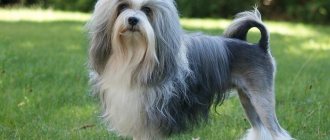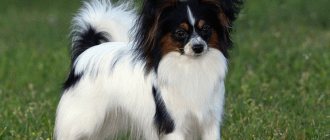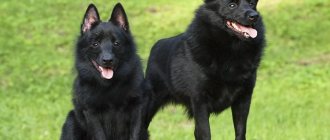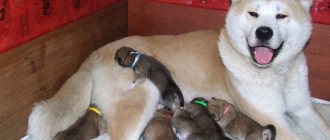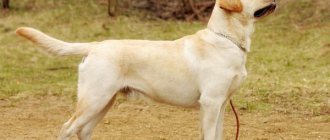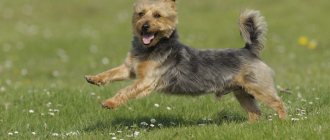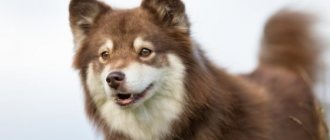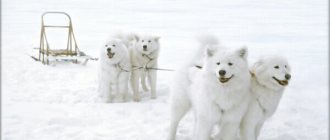Breed characteristics
| Short description | |
| Origin: | They were bred on the Alaska Peninsula by the Malamute tribe. |
| Conditions of detention: | He likes more free space, so a country house or dacha is better, but it is not advisable to keep him on a leash, and the enclosure should be very spacious |
| Purpose: | Riding |
| Color: | Black and white, seal and white, gray and white, silver and white, white, red and white, sable |
| Wool length: | Different at each site, tough |
| Adult dog size: | Cables – 64.5 cm, 40 kg; females – 59 cm, 36-39 kg |
| Average life expectancy: | 12-17 years old |
| Walk: | Long walk required, preferably 3 times a day |
| Physical activity needs: | High physical activity needs (regular or daily exercise for more than 3 hours per day) |
| Fédération Cynologique Internationale (FIC) classification: | Type of primitive dogs (fifth group), northern sled dogs (first section) |
| Puppy price: | 10,000-30,000 rubles (depending on pedigree) |
Description of the breed
In the hardy, strong body of the Malamute, which is prone to dominance, hides a sincerely friendly, kind, sociable dog. He cannot be left without physical activity, otherwise the dog will turn into a stupid, lazy animal without willpower and aspirations.
Due to their external similarity, the Alaskan Malamute is often confused with a husky. For the uninformed, they do look alike, but dog breeders know that the similarity ends at color. In terms of endurance, strength and character, the Arctic dog wins.
The Alaskan Malamute is the largest sled dog. Powerful muscles and impressive size allow this animal to perform complex, time-consuming tasks. The fluffy cover helps to survive in the “ice age” conditions. This dog can run for days in the cold, but feels uncomfortable in the heat.
History of the origin of the species
The Malamute was bred on the Alaska Peninsula by hunters and fishermen of the Inuit nomadic Malamute tribe. These were very strong and brave dogs, but over time they lost many of their qualities.
Malamutes are direct descendants of wolves. Therefore, they bark quite rarely. These dogs make a "grunt" noise.
In the 19th century, large deposits of gold were found in the Klondike, and the “gold rush” began. In those days, Malamutes, due to their qualities, were most in demand. However, at the same time they began to lose many of their good characteristics. They began to crossbreed with smaller and faster species, which completely ruined the breed.
Initially, Malamutes were used as sled dogs, for carrying heavy loads, and even for participating in dog fights. However, during the “gold rush” they lost their last two properties.
In the 20th century, the Americans were able to restore the breed, after which they began to organize harness racing. And in the second half of the 20th century, the International Canine Federation recognized the Malamute standard, which is still in effect today.
Distinctive features
The main features of the Alaskan Malamute:
- Size and weight . The cables can grow up to 64.5 cm and the weight can reach 40 kg. Smaller females – up to 59 and 39 kg.
- The head is large, but proportional to the body. The muzzle is voluminous, not elongated and not pointed.
- The eyes are slanted and brown. It is very rare to find a Malamute with blue eyes.
- The ears are triangular in shape, set wide apart and slightly rounded at the tips.
- bite . The teeth are strong and sharp.
- Nose is black. The exception is representatives of the red color.
- The neck is strong, slightly arched.
- The legs are very strong and muscular. The hind ones are thicker than the front ones.
- The body is not short, proportional to the body. The sternum is well developed. The back is straight, the croup is slightly sloping. A strong and muscular loin, but it greatly lengthens the back, which is a disadvantage of the breed.
- The tail is thick, medium set, slightly curled, but does not reach the back.
- The coat is very hard, with a very thick undercoat underneath.
- Color: black and white, seal and white, gray and white, silver and white, white, red and white, sable. The undercoat is always white or cream, only the color of the guard varies.
- Muzzle markings "headphones" connecting at the center of the forehead, dark spots under the eyes extending to the ears, a "bar" running the entire length of the muzzle, a white stripe or "star" between the ears, dark spots around the eyes.
Breed standard
The Malamute is a powerful dog, strong, compact, with a deep chest and long, coarse hair. The chest is well developed. The back is straight with a powerful and muscular lower back. The depth of the chest is equal to half the height at the withers.
The head is strong and wide. It is proportional to the size of the entire dog. When standing and running, the Malamute proudly raises it.
The neck is strong, muscular, somewhat arched.
The forelimbs have strong muscles and strong bones. The hind limbs are wide. When viewed from behind, they will be located along the same line as the front legs. The thighs are well developed, with strong muscles.
Characteristics of the Malamute breed will be incomplete without a description of its character . This dog is active, mobile, good-natured, loves games and long walks. Friendly with children. However, he treats other dogs poorly and is aggressive towards them.
Since Malamute initially lived in a pack, it loves to constantly be in society, in the family. He can be trained, however, as a rule, as long as he is interested in it. Very soon, the dog may get bored with the same commands, and he will simply be stubborn in repeating them.
Malamute is smart and cunning, has self-esteem. It is advisable that he be raised not by one person, but by all family members. With proper training, attention and care, he becomes an excellent companion.
Owners of private yards will need to be aware of one characteristic feature of representatives of this breed - they love to dig. They prefer to do this business often and devote a lot of time to it. The fact is that their instincts still contain the desire to look for digging animals. Therefore, when implementing it, the dog will dig through the entire plot of land. There can be only one way out - teaching the dog to dig in one place, say, in a box with sand specially equipped for him.
If you decide to have this miracle in your apartment, then be prepared to say goodbye to several pieces of furniture, because if the Malamute does not have somewhere to splash out its endless energy, then it will release it on the first furniture that comes under its paw. Therefore, it is important to take your pet for walks more often, so that he can run around and have fun there, then there will be no problems from him in everyday life.
And yet, if you want to buy yourself a protector and guard, then this breed is completely unsuitable for this. They are friendly towards strangers and cannot bark.
Among the advantages, it is worth mentioning the following characteristics of the Alaskan Malamute breed:
- beautiful appearance;
- friendly character;
- they practically do not bark, they only growl;
- absence of a pronounced dog smell;
- non-aggressiveness;
- strong immunity;
- endurance.
Representatives of the breed also have disadvantages:
- difficulty in training;
- stubbornness;
- independence and disinclination to subordination;
- loss of a large amount of hair during the molting period.
We recommend reading about large dog breeds: Akita Inu, Alabai, German Shepherd, Tibetan Mastiff, Doberman, Rottweiler, Cane Corso, Staffordshire Terrier.
Photo of an adult dog
Photos of puppies
Features of character and behavior
- Malamutes do not tolerate loneliness and isolation at all. Therefore, it is better not to keep them on a chain or in an enclosure, otherwise the dog may get bored and harbor a grudge against its owner.
- By nature, Malamutes are quite stubborn and have high intelligence. Therefore, without proper upbringing, a dog may cease to respect its owner and become attached to other people.
- They can also get tired of monotonous actions . You should not force your Malamute to fetch the stick too many times; he may feel that he is being treated with disrespect.
- Malamutes are very difficult to train and are very stubborn . But thanks to their high intelligence and good memory, they remember all commands very well.
If an animal is poorly raised, psychologically traumatized (especially to a puppy), or simply treated cruelly, then this harmless and friendly animal can become evil forever.
Advantages
Among the advantages it is worth noting:
- Friendliness and sociability;
- Mind;
- Easy to care for;
- Silence (barks only when absolutely necessary).
Flaws
The Alaskan Malamute has many disadvantages:
- Very stubborn. This breed is quite difficult to raise because they do not like to be obeyed;
- They do not like repeated repetition of monotonous actions;
- A bad guard, despite his impressive external qualities. This is explained by excessive kindness towards absolutely all people;
- The need for constant and heavy load;
- She loses a lot of fur during the shedding season.
Character of Malamutes
Alaskan Malamutes perceive everyone around them as their pack. They need to be constantly surrounded by people. They are friendly with everyone, affectionate and welcoming. They greet guests with joy and try to please them. These are not monogamous people; they easily get used to a new owner. But they constantly need attention.
The Malamute is a dog that remains a puppy until it is 3 years old. She is active, cheerful and playful. Irrepressible energy requires an outlet, so the dog never sits still and constantly demands attention. But even as an adult, he does not tolerate a sedentary lifestyle. He needs long walks, jogging, and intense exercise.
Malamutes get along well with children and can become a caring nanny and playmate. But it is not recommended to leave him alone with children. The dog will not deliberately harm the child, but since he strives to dominate and is quite large in size, he may accidentally injure him.
For the same reason, it is undesirable to keep him in the same house with small dogs, cats, and even more so rodents and birds. Malamutes have a desire to be superior to others and to command. And he can hunt small animals. Only with proper upbringing and early socialization can this dog get along with other pets.
Malamutes are not suitable for the role of guard and watchman. These are good-natured dogs, they do not bite. Moreover, they do not know how to bark, but only howl.
The photo shows the behavioral features of adult Malamutes:
With baby
With a girl
In the forest
Don't be sad…
Education and training
Malamutes are strong and independent, so it is very important to pay a lot of attention to their proper upbringing. These are smart, quick-witted dogs, they have a good memory and the ability to make decisions independently. It is very difficult to train them. To do this, you need to immediately gain authority, show firmness and perseverance. This dog will constantly strive to dominate and test all family members.
You need to raise a puppy from an early age. In order for him to immediately feel who is boss in the house, you need to follow several rules:
- the people eat first, and then the dog;
- the dog comes through the door and goes up the stairs after the man;
- should not be allowed to sleep on the bed;
- You need to pet the dog while eating;
- do not feed from the table;
- A dog should not win games or take away toys from a person.
You can independently teach your puppy to respond to a nickname, to be calm towards cars, sharp sounds, and other animals. From an early age you need to learn the basic commands: “place”, “to me”, “no”, “fu”, “near”, “sit”, “stand”.
Classes should be carried out in a playful way; Malamutes quickly lose interest in monotonous training. You cannot shout, show aggression or hit this dog. It is important to find a common language with your pet and reward it more often for success. From 4 months, it is advisable to visit the dog playground and complete a general training course.
An interesting video about the character and upbringing of these dogs:
Video: Training
Care and maintenance
Malamutes are considered a fairly clean breed, so they can be washed once every two months, and they themselves love to wash themselves. However, the most difficult thing is caring for the coat. You need to thoroughly rinse off the shampoo and dry it well. The Malamute needs to be combed 3 times a week . To do this, it is better to use a brush with metal teeth. Malamute females shed twice a year, males - once.
- ears should be cleaned at least once every 2 weeks. A cotton pad is used for this, but a dry cloth will also work.
- Several times a week you need to brush your teeth using special products.
- Nails need to be trimmed approximately once every 2 weeks . However, it is better not to use simple scissors, because they can split the tip of the claw. To do this, it is better to use a special nail clipper. It is necessary to trim the nails very carefully; you must not touch the nail pulp, so that blood does not bleed and infection occurs.
Nutrition
Alaskan Malamutes have a predisposition to obesity . Therefore, they need constant exercise and proper nutrition.
Breeders recommend accustoming your pet to natural food. However, you can also feed dry food. In this case, super-premium food is selected, and it is desirable that it be a well-known brand. It is very important that the composition contains meat. But it is better to avoid food containing grains.
- It is recommended to feed puppies no more than 3 times a day , but it is better to feed an adult dog only once .
- The puppy's diet should consist of dairy products, meat (must be finely chopped first), vegetables (except potatoes) and boiled fish (bones must first be removed).
- You should not switch your pet to dry food right away. It's better to do it gradually.
- Sweet, smoked or spicy foods should be avoided. This can have a negative impact on your pet's health.
Representatives of this breed very easily get used to tasty but unhealthy food. If you try it at least once, they may refuse to eat any other food for several days.
Health
The Alaskan Malamute is one of the breeds with excellent health, but there is no breed that does not have a predisposition to any disease.
The lifespan of a Malamute is 12-16 years. However, this is not a deadline. Proper care can significantly prolong a pet's life.
The Malamute's homeland is a peninsula with very harsh conditions, where there is always terrible cold. Therefore, harsh winters are not scary for them. But with hot summers everything is much more complicated.
During such a period, there should always be enough drinking water in the house . It is desirable that it be cool. To do this, sometimes add a little ice to the water. It is also necessary to allocate a cool and shaded place for the pet (usually the dog chooses it himself). It is very useful to bathe your Malamute more often in a pool, river or pond.
During periods of extreme heat, you should not burden your pet with work or any strenuous exercise. It is better to postpone classes until cooler times: early in the morning or in the evening after sunset.
The Malamute can adapt well to the state of the environment. Therefore, over time, it will become easier for your pet to endure the heat. The main thing to remember is a few rules:
- You should not leave your pet in a closed car, or even with the windows slightly open, for a long time;
- You should not trim your Malamute's coat in the summer. It protects the dog from excessive heat;
- Your pet should always have water.
If you take proper care of your pet, you can avoid heat stroke.
Vaccinations
To avoid unwanted diseases, you need to get several vaccinations. But, of course, you can’t inject everything at once. You must adhere to the schedule:
- 7-8 weeks: vaccinations against parainfluenza, distemper, leptospirosis and adenovirosis;
- 12-13 weeks: revaccinations of everything from the first point and vaccination against rabies;
- Then every year it is necessary to revaccinate against all of the above diseases.
If before the puppy came to be picked up, he had already been vaccinated, then this should be written down in his passport.
Diseases
Before adopting a Malamute, you need to be thoroughly familiar with the diseases to which it is predisposed.
The most common malamute diseases are:
- Retinal atrophy;
- Improper functioning of the musculoskeletal system;
- Gastric volvulus;
- Irregular pigmentation of the nose;
- Adenocarcinoma of the anus;
- Hemeralopia (“day blindness”);
- Chondrodysplasia – weak joints due to improper development of cartilage tissue.
Almost all of these diseases are hereditary. Therefore, before adopting a puppy, you need to ask the breeder if he has a predisposition to any of them.
Walk
The Alaskan Malamute is an active breed. Therefore, he needs to be walked for a very long time and given serious exercise. With such a dog you can’t just go out and walk a circle around the house. It is better to walk your Malamute for several hours in a forest or park (preferably in a special one with obstacles and slides).
It is necessary to let your pet off the leash for a while so that he can run freely. Lack of exercise can lead to unwanted diseases.
Grooming
Caring for a Malamute's coat is quite difficult. It should be thoroughly combed at least once a week. Once every 2 weeks, tidy up the undercoat using a slicker brush. All this is necessary to prevent tangles from forming. During molting, all these procedures must be carried out more often.
When choosing a shampoo, you need to pay attention to products for thick coats, and you also need to purchase conditioner.
It is necessary to rinse off the shampoo for a long time and thoroughly. Otherwise, you can cause irritation to the dog’s skin and mucous membranes. You also need to very carefully dry the wool with a hairdryer after water treatments so that it looks beautiful.
Mating
Malamute females begin puberty around the eighth month of life. One to two weeks before the first heat, the pet begins to exhibit strange behavior and urinate frequently, which is completely normal.
The first heat takes place in two stages:
- Mucous and bloody discharge appears (at this moment it will not be possible to breed - the female will not allow the male to come to her). This lasts for about ten days;
- Transparent discharge appears (mating can begin).
However, experienced breeders do not recommend breeding during the first heat, otherwise the offspring will be weak.
For the first mating, you can ask the breeder which cable is best to choose. The most important thing is that both Malamutes are healthy.
How is the knitting itself carried out? Usually mating is carried out in the morning (on an empty stomach).
There are two types of matings:
- Free – when they tie up already experienced parents who are not getting together for the first time;
- Manual – when the bitch is inexperienced and the couple needs help.
In the case of the second one, you need to act carefully. First, the dogs must get acquainted (this should take at least two hours). Then, to avoid injury, put a muzzle on the female and attach a cable. First you just need to put his paw on his back. This creates the illusion for the female that the cable has straddled her. And then mating already occurs. It can last from 15 to 40 minutes , and it is better to repeat it after 24-48 hours . If the mating was successful, you can expect a replenishment.
After this, you need to prepare for the appearance of puppies. To do this, it is better to allocate a separate room or barn and create all the necessary conditions for children there.
In the first month of pregnancy, you should not reduce the load; this will not harm the health of either the mother or the puppies. But in the second month it is better not to burden her with heavy exercises and switch to a lighter diet.
Approximately 10 hours before birth, pushing begins, and the pet begins to behave restlessly. At this moment, it is better to take her to the sun lounger and not leave her side. You shouldn’t forcefully hold her on the lounger; it’s better to just turn the attention to yourself with your affection. But as soon as labor begins, it’s better not to touch the mother. And after childbirth, you shouldn’t bother your family either. The mother must understand the new situation and begin feeding her children.
After some time, you need to call the female to you and wipe her genitals with a warm, clean rag. To do this, ask one of your relatives to take the Malamute for a walk and check for weak or underdeveloped puppies. They usually don’t leave them, because the chance that they will survive is negligible.
Over the next month, it is preferable to feed the female Malamute with broths, cereals, cottage cheese and kefir, and only then switch to food. It is necessary to ensure that there is always water in the bowl.
Key points in training
The Alaskan Malamute is a very stubborn dog breed, so it can be quite difficult to train . However, this species is distinguished by its keen mind and excellent memory, so they understand commands very well.
Tips for training and raising a Malamute:
- As soon as you bring home a Malamute puppy, you must immediately show who is the owner;
- You need to train with your dog every day;
- Commands should not be shouted. They must be pronounced clearly and concisely;
- Encouragement should be alternated with treats and words;
- It is better to train in the form of a game at home or on a walk;
- To make yourself more impressive, you need to focus on the letter “r” during the command.
- Read about how to properly train a dog in the article: “Training a puppy: effective methods from dog handlers, learning commands at home.”
Pros and cons of the Alaskan Malamute
A breed can only be judged from the subjective assessments of dog owners. When indicating the malamute's shortcomings, the following traits are often listed:
- excessive manifestation of independence and decision-making without the owner’s command;
- the desire to dominate relatives and people;
- the inability of the breed to defend itself and its entrusted territory from attack.
These negative aspects are a consequence of the fact that a person decided to make a dog as a pet against its genetics. The Alaskan Malamute will never be a guard dog. Only its large size can scare away intruders.
Representatives of the Malamute breed:
- loving;
- affectionate;
- devotees;
- friendly.
Expert opinion
Anna Abramenko
An avid dog lover. Experience in veterinary medicine since 2009.
Ask a Question
It is especially worth noting the ability of these dogs to be friends with children. They are excellent babysitters for babies. They will always watch and play carefully.
How to choose a puppy
The first step to purchasing a puppy is choosing a breeder.
- You need to remember the main rule: an experienced and responsible breeder will never sell puppies in pet stores, bird markets or on sites such as Avito.
- Stores usually offer for sale weak representatives of the breed that are prone to hereditary diseases. By adopting such a puppy, there is a risk of multiple expenses for the treatment of the pet.
- You should also not contact kennels that produce a large number of dogs. It's better to choose.
Experienced breeders can advise on all questions regarding the breed. Therefore, before moving on to choosing a puppy, you must first have a very long conversation with the breeder, ask all the important questions. And during this conversation, it will become clear whether this breed is worth purchasing, and the breeder will understand whether the new owners will cope with the Malamute.
A good breeder should ask:
- How many people does the family consist of? How do each of them feel about dogs?
- What is the family's lifestyle like?
- Where do the future owners live: in a house or in an apartment?
- How do neighbors feel about dogs?
- Does the family have a yard or a spacious enclosure?
- What is the knowledge of family members about the breed?
An experienced breeder should:
- Answer any question regarding the breed;
- Be a member of the breed club (if it exists);
- Be a repeated participant in exhibitions (not only in Russia);
- Offer sterilization;
- Provide the puppy's passport;
- Provide a guarantee of health and absence of genetic defects, as well as temperament testing (also with the issuance of a guarantee);
- Demand the return of the pet if the owners cannot provide proper living conditions for the malamute;
- Consult owners on all issues that arise while raising a puppy.
When choosing a puppy you need to follow some rules:
- Please note: the puppy must be active;
- Outwardly he must be healthy and clean;
- It is necessary to clarify whether there are any health problems, and what vaccinations were given, and which ones still need to be done;
- Determine the possibility of the presence of worms;
- Find out whether the parents had hereditary diseases;
- Ask how friendly the parents were.
Selection of puppies
It is better to purchase a Malamute baby from a registered nursery. Purchase from private owners is allowed. To confirm the purebred of the breed, the dog must have SCOR or RF documents. The absence of defects in appearance and psyche is important.
Puppies aged from 1 to 4 months are suitable for sale. Experienced breeders advise picking up babies earlier, before they have time to acquire habits of gregarious existence. But only in older dogs can exterior characteristics be accurately determined.
A healthy animal shows activity, curiosity, and a good appetite. Upon examination, the puppy should not have a bulging belly. Limbs are straight and wide. The eyes are dark, and the color of the coat is according to the standard. The fur is fluffy and thick.
When choosing an Alaskan Malamute puppy, you can test it: put a narrow collar around the neck and slowly pull the baby along. If the animal does not try to crawl away or whine, but goes after short persuasion, then it is a balanced dog with leadership qualities.
Malamute and Husky: differences
Malamutes and huskies are a little similar in appearance, and so many people wonder: how are they different?
- First of all, you should pay attention to the homeland of dogs . Malamutes were bred in Alaska, and huskies were bred in Siberia.
- Malamutes are much larger than huskies. The height of the former reaches 40 cm (male), and huskies - up to 56 cm. This also affects driving performance: Malamutes are capable of carrying heavier loads.
- The Malamute's coat is coarser and coarser , and the tail is not as curled.
- Malamutes always have brown eyes, and it is very rare to find a representative with blue eyes. For huskies it's the other way around.
- By nature, huskies are more friendly and active, and can become the best nanny for children . Malamutes are intellectual and quite stubborn, although they are also friendly.
- There are differences in the diet of these animals . Huskies are unpretentious eaters. They can be fed twice a day. But Malamutes suffer from a digestive system, and they are prone to obesity, so you need to take a very responsible approach to feeding them.
- Raising a Malamute is much more difficult . This breed is distinguished by strong stubbornness and a great love of freedom. Therefore, he must be brought up strictly from the first days after arriving home.
The Alaskan Malamute is a very loyal friend and has a number of good qualities. However, this is a very stubborn breed. They are also difficult to care for, despite their love of cleanliness. Therefore, it is better to think several times: is it worth adopting this dog? It will bring a lot of joy, but also a lot of trouble.
Differences from Husky
Malamutes are often confused with huskies. Indeed, in appearance they are very similar, especially if you see only a representative of one of these breeds. If you put these two dogs side by side, then the differences in appearance, height and weight, facial features, and character will be obvious.
In addition, initially these two breeds were bred for different purposes: huskies - for sled racing, participation in competitions, and fast transportation of small loads, and malamutes - for transporting large loads at low speed over long distances. That is why they are often called the “northern train”.
Based on the purpose of the breeds, we can highlight the main difference between Malamute and Husky . The first is more resilient, the second is faster, lighter and more agile in its movements.
Another characteristic difference is the structure of the body. The Malamute is powerful, athletic, muscular, with a deep chest and a wide skull. This dog is slightly higher at the withers than its relative. Husky is a little stocky, medium in size.
Alaskans have longer, fluffier fur. The most common color is gray-black. Siberian Huskies have a less fluffy coat. They come in different colors - black and white, gray and white, gray, white. There are striking differences in the dogs' faces. The Malamute has a good-natured expression. Eyes are only brown; other colors are considered defects. Husky eyes can be of different shades - brown, blue, gray, etc. They can be of different colors. And the muzzle often has an angry or wary expression.
